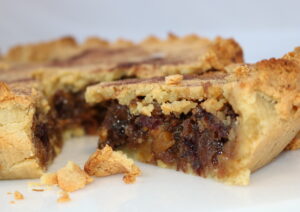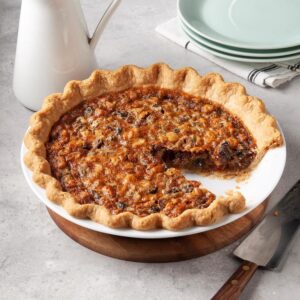My Momma’s Christmas Pie

My childhood Christmases were always a favorite holiday. The smell of our freshly cut tree with its shiny glass ornaments, glistening tinsel, and twinkling lights. The colorfully wrapped gifts strewn under it. Bowls and plates filled with special Christmas treats through the house — hard rock candy ribbons (my father’s favorite), homemade chocolate fudge and peppermint bark, Uncle Junior’s peanut brittle. And of course, my momma’s pies.
Of all the pies my momma baked during the holiday season, there was one very special pie she made just for herself . . . her Christmas mincemeat pie. My father wasn’t a fan of mincemeat, and although I enjoyed just about anything she made, that pie was really her’s and her’s alone.
 For those not familiar with mincemeat pie, it consists of a golden pastry crust filled with dried fruits, apples, spices, and sometimes suet, brought to America by English settlers during the 17th century. Mince pie, as it is referred to in Britain, is traditionally served during the Christmas season. But how it came to be synonymous with Christmas is a story within itself.
For those not familiar with mincemeat pie, it consists of a golden pastry crust filled with dried fruits, apples, spices, and sometimes suet, brought to America by English settlers during the 17th century. Mince pie, as it is referred to in Britain, is traditionally served during the Christmas season. But how it came to be synonymous with Christmas is a story within itself.
As the story goes, European crusaders returning from the Holy Land at the end of the 13th century brought with them Middle Eastern cooking methods and recipes containing meats. fruits, and spices popular at the time. Among the spices were cinnamon, cloves, and nutmeg which many English authors, including John Tombs the acclaimed English antiquary, viewed as being among the gifts presented to the Christ Child by the Biblical Magi. Other religious symbolisms surrounding early “shrid pies” (as they were known then) included their size and shape, believed to be larger and oblong, to resemble the manger in which Jesus was born.
 Over the years mince pies have been known by several names, including “minched pie,” “mutton pie,” “shrid pie,” and of course, “Christmas pie.” The ingredients in todays mince pie have also changed. Even as late as the mid-1800s, the pie contained beef, veal, pork, mutton, or various game. These finely minced (from the Latin word “ minutes” meaning small) meats were blended with various fruits including raisins, currants, apples, and orange peel, then seasoned with spices such as cloves, nutmeg, and brown sugar. Brandy, cognac, or some other alcohol was usually added as an additional preservative, as well as flavor.
Over the years mince pies have been known by several names, including “minched pie,” “mutton pie,” “shrid pie,” and of course, “Christmas pie.” The ingredients in todays mince pie have also changed. Even as late as the mid-1800s, the pie contained beef, veal, pork, mutton, or various game. These finely minced (from the Latin word “ minutes” meaning small) meats were blended with various fruits including raisins, currants, apples, and orange peel, then seasoned with spices such as cloves, nutmeg, and brown sugar. Brandy, cognac, or some other alcohol was usually added as an additional preservative, as well as flavor.
Today, most mincemeat recipes actually omit the meat although some add a bit of suet or shortening. In fact, many home bakers, including my momma, prefer using commercially prepared mincemeat filling rather than making their own, which can be a time-consuming task. The pie’s size has also changed. In America mincemeat pies (as they’re still known) are full-sized, whereas in Britain they are commonly small individual-sized treats.
 Mincemeat pie seems to be making a comeback, as the revival of America’s forgotten pies continues—something my momma would be delighted to see. For those of you who want to try this delicious Christmas pie, I’ve included her recipe below. And I do recommend using None Such Classic Original mincemeat filling (available from Amazon), my momma’s favorite brand.
Mincemeat pie seems to be making a comeback, as the revival of America’s forgotten pies continues—something my momma would be delighted to see. For those of you who want to try this delicious Christmas pie, I’ve included her recipe below. And I do recommend using None Such Classic Original mincemeat filling (available from Amazon), my momma’s favorite brand.
Sugar’s Mincemeat Pie
Recipe makes 8 to 10 servings
Whatcha Need:
- 1 jar (20-1/2 ounces) None Such Classic mincemeat (2-cups)
- 1-1/2 cups pecans or walnut pieces, chopped
- 1 Gala apple, peeled, cored, chopped (about 1-1/2 cups)
- 1/2 cup dried figs, chopped
- 1/3 cup brown sugar, packed
- 1/3 cup dark rum
- 2 teaspoons lemon zest
- Dough for 9-inch, double-crust pie shell
- Whipped cream for serving (optional)
Whatcha Do:
- In medium bowl, stir together prepared mincemeat and remaining ingredients. Cover and refrigerate overnight.
- Remove mincemeat filling from refrigerator and let come to room temperature, about 45 minutes. Meanwhile, heat oven to 400°F and place rack in middle of oven. Stir mincemeat mixture well and pour into prepared pie shell. Top with second crust cut to fit and slit the top; or slice into strips and arrange into a lattice top.
- Bake on lowest oven rack 40 to 45 minutes or until pastry is golden brown. Cool completely on cooling rack, about 5 hours.



